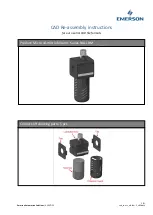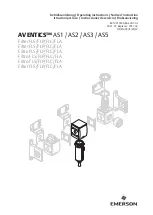
Suggested Service Call
Procedure
Hydro-Action® Industries’ aerobic treatment systems should be serviced at least every six months per NSF
International regulation. Some states require more frequent calls. This service call procedure meets all NSF
International requirements for the Aerobic Treatment Unit as well as pretreatment and pump tanks.
Service
Procedure
:
1.
Remove cover from OPS® Operations Control Center. Open access covers on treatment unit, pre-treatment
and pump tanks. Observe the mixed liquor in the mixing chamber of the treatment unit. Note on the
inspection report the condition per your Plant Condition Chart. If there is a noticeable odor in either the
treatment unit or pump tank, take a Settable Solids Test sample and set aside. This test may be observed after
45 minutes settling time and read per your Plant Condition Chart.
2.
Gauge back pressure in the air system by attaching a 5 psi air gauge to the provided schraeder valve. Note
the reading on your inspection report. Back pressure should be between 2.75 psi and 3.5 psi for normal
operation. If the back pressure exceeds 3.5 psi, inspect the diffuser assemblies. If back pressure is allowed to
exceed 4 psi for any length of time, air pump damage may occur. In an initial visit to an existing system,
inspect the diffusers prior to taking air pressure readings; if the diffusers are clogged, the overpressure you
will encounter may damage the 5 psi gauge. You may use compressed air to try and blow the diffusers clear.
3.
Remove small air pressure tube from barbed fitting beside schraeder valve. Low Air Pressure Alarm
should sound. Re- attach tube to barbed fitting.
4.
Inspect air pump filters, cleaning or replacing as necessary.
5.
Remove any surface sludge from the mixing chamber and clarification chamber. Dispose of this
sludge as local regulations require.
6.
Inspect high level alarm function by lifting the float. Alarm should sound. Note results in your inspection
report.
7.
Take a sludge level reading from the mixing chamber and note in your inspection report. Read settle able
solids test and note results on your inspection report. Pour test sample back into mixing chamber. Close the
access cover and secure with security screws.
8.
Lift high level alarm (upper) float in pump tank to assure proper operation. Alarm should sound.
9.
Remove effluent pump stalk. Lift lower float to test. Pump should start when float is lifted above level.
Do not run effluent pump over 5 seconds by this method or effluent pump damage may occur.
10. Remove and clean effluent pump screens. If a Chlorine Residual Test is to be performed, take your sample at
this time.
If the system is chlorinated, check chlorine level and add chlorine if necessary.
11. Replace pump stalk and replace access cover, securing with security screws. Replace cover on OPS®
unit and secure with security screws.
12. Take a sludge reading from the pretreatment tank and note in your inspection report. Replace cover and
secure with security screws.
13. Complete your inspection report and leave a copy with the homeowner.
14. Mail a copy of your inspection report to the local authority and retain the original in your files.
Содержание AP Series
Страница 1: ......
Страница 15: ...Appendix 3 Technical Manual for Timers Grasslin 24 Hr Timer Omeron Micro Dose Timer ...
Страница 29: ......
Страница 30: ......
Страница 31: ......
Страница 32: ......
Страница 33: ......
Страница 34: ......
Страница 35: ......
Страница 36: ......
Страница 37: ......
Страница 38: ......
Страница 39: ......
Страница 40: ......
Страница 41: ......
Страница 42: ...Appendix 5 Drawings AP 500 ATU LPA 500 ATU AP 600 ATU AP 750 ATU AP 1000 ATU AP 1500 ATU ...









































